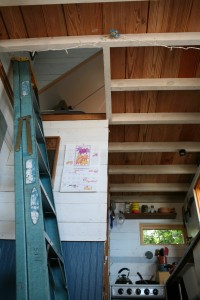
Lots of folks talk about utility and organization of physical space when it comes to living the tiny life. This is absolutely essential to creating a home that truly meets our essential need for shelter but I?ve found less conversations when it comes to balancing the emotional and mental aspect of relationships in a small space. I thought it might be helpful to discuss the ways that Cedric and I have been learning to navigate tiny living and ensuring the health and stability of our long-term, romantic relationship.
Designing private and communal space.
When designing La Casita, privacy was a big issue. We were trying to figure out how in the world we were going to create communal and private space in such a tiny structure! Cedric and I both believe it?s essential to have these designated areas to sustain a healthy relationship. At first, we tried to build two separate rooms downstairs but there was so much wasted space in the design we ended up tearing it all out and starting over! It was a tough decision but ultimately the best one.

In our original plans we had an open loft space but after realizing we weren?t going to be able to separate the space downstairs, we decided the loft would be closed off. This has done wonders for our need for alone time. When one of us is in the loft, it feels like a completely isolated, cozy place that you can relax, read, work, meditate, write letters or take a nap. When one person is downstairs and one up, you get a feeling of separation that allows us to recharge and, in the case of a disagreement or high emotions, a sanctuary to cool off.
Open, honest communication.
Before Cedric and I moved in to La Casita, we decided to take a workshop on Non-Violent Communication. ?Non-Violent Communication is a method developed by?psychologist?Marshall Rosenberg that focuses on reconnecting ourselves with our compassionate nature, even under the most trying of circumstances. It implements a non-judgmental, non-accusatory?structure of expressing feelings and needs. You can?t hide from issues in a home the size of many people?s garden sheds! It?s absolutely impossible and if you try, conflict will quickly escalate. Cedric and I are constantly working on hearing each other compassionately and meeting each other?s needs and it is not without challenges but I?ve found that living the tiny life benefits our relationship in that we can?t let things fester. We have to face the issues that crop up. ?Working on our relationship this way creates a continued emotional closeness necessary to living in such close physical proximity.
home the size of many people?s garden sheds! It?s absolutely impossible and if you try, conflict will quickly escalate. Cedric and I are constantly working on hearing each other compassionately and meeting each other?s needs and it is not without challenges but I?ve found that living the tiny life benefits our relationship in that we can?t let things fester. We have to face the issues that crop up. ?Working on our relationship this way creates a continued emotional closeness necessary to living in such close physical proximity.
Patience and Cooperation.
I thought I had patience before moving in to a tiny house. I worked with preschool children so I understood the importance of patience and cooperation. While my experience in childcare certainly helped, it?s different with your partner in 100 sq. feet! Our home is narrow and we often have to squeeze past each other to get to the bathroom or sink. I would have to say that width is something I would like more of! We have to wait to put on shoes, hang up coats, climb the ladder, get in to bed, get out of bed, get dressed, use the sink and prepare meals. It takes continued cooperation to live in such a confined space and makes bumping elbows inevitable. Although, I do love the fact that no matter where one of us is in the house, we can pass each other items with relative ease. It?s really convenient when nearly everything is within arms length!
R-E-S-P-E-C-T!
Beginning of the week, Cedric and I were having a fight. We said things we didn?t mean and lost sight of some of our own rules when communicating. Practicing respect at all times, including when we?re mad, can be a challenge but it?s essential. I?ve been reading and re-reading this post to try and remind myself that making it work is hard work but it?s not without its rewards. We spent time in separate spaces, cooled down and went back to talking using honest, compassionate conversation. ?To respect each other is to take responsibility, listen and communicate without accusation and blame. We have deep seated patterns in our society and only as adults have we begun to take action to learn how to better communicate. We fell in to our own bad patterns this week but through patience, privacy, ?respect and open communication we were able to work through our disagreement. We couldn?t hide from it in the tiny house so we dealt with it, not very well at first, but in a short time we were able to settle our argument in a healthy manner. It reminded me why I love living the tiny life and how emotionally we can grow when we decrease our living space.
While most of the above points pertain to any sustainable, healthy relationship, they certainly magnify as physical space shrinks! Families that live in tiny houses have a great perspective on how to navigate relationships in a limited space. Having children creates an entirely new dynamic and exemplifies the advantages and challenges of living the tiny life. Keeping the balance can be difficult but often presents us with wonderful rewards, such as increased emotional closeness, healthy communication and overall satisfaction in our intimate relationships. For us, tiny living continues to challenge us to meet and express needs and live a more holistic life through our love and compassion for each other.
Your Turn!
- Do you think tiny living puts strain on relationships?
- How do small spaces benefit your relationships?
- How do you balance relationships in under 100 sq. feet?
Source: http://www.thetinylife.com/relationships-the-art-of-tiny-living/
ncaa basketball tournament 2012 megamillions winning numbers lotto winner jerry lee lewis cesar chavez winning lotto numbers lottery tickets
No comments:
Post a Comment
Note: Only a member of this blog may post a comment.